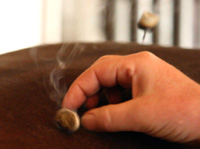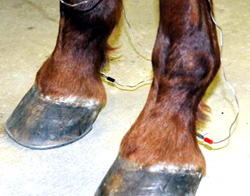Case reports
Case Report recurrent Tendinitis (Bowed Tendon)
Case Report Ataxia and Left Hind Lameness after Stallion Evaluation
Case Report: The Treatment of a Nondisplaced Radial Spiral Fracture in a Standardbred Horse
Case report recurrent Tendinitis (Bowed Tendon)
First Treatment 6/22/2007
History:
In spring 2006 the filly bowed her tendon on the right front leg. The
bowed tendon had been treated 3 times conventionally and had recurred
each time when the horse came back to training. From November 2006 to
March 2007 the horse was stable rested to achieve a healing. In March
2007 with no swelling, pain or lameness, the filly’s training was resumed.
During her first speed work she bowed tendons in both of her front legs.
Examination:
 Severe lameness left (!) front and right hind. Tendons on both front leg
are very painful on palpation. Filly shows poor muscular development,
especially for a thoroughbred filly in training. The acupuncture exam
shows a marked imbalance of the meridians. Points that refer to the hips
are highly reactive. Osteopathy exam shows subluxations of the first cervical
(C1),the TMG, both shoulders and the right sacroiliac joint.
Severe lameness left (!) front and right hind. Tendons on both front leg
are very painful on palpation. Filly shows poor muscular development,
especially for a thoroughbred filly in training. The acupuncture exam
shows a marked imbalance of the meridians. Points that refer to the hips
are highly reactive. Osteopathy exam shows subluxations of the first cervical
(C1),the TMG, both shoulders and the right sacroiliac joint.
Treatment:
Acupuncture is performed to balance the meridians. Acupuncture points
are injected with a homeopathic drug to strengthen the hips. The subluxations
are treated by osteopathic manipulation. The horse had to be hand walked
for three days. After three days she walked in the treadmill twice a day
(walk under the saddle was not possible because of her temperament). A
homeopathic complex remedy promoting joint and tendon healing is prescribed.
Second treatment 7/6/2007

Good development.
Right front (old injury!) not painful on palpation. Left front is only
minimally painful on palpation. The swelling is almost gone. Only a slight
lameness is observed on the left front. Acupuncture exam show a dramatic
reduction in reactivity. Subluxations are found in the cervical region,
shoulders and the pubic symphysis. The sacroiliac joint is free.
Treatment:
Acupuncture and moxibustion are done to balance and to strengthen the
meridians. This treatment is possible because the horse is much more comfortable
and cooperative.
Third treatment 7/24/2007
The filly shows further improvement. Only a tiny bit of swelling left on the right front. Acupuncture exam shows only mild reactions. The horse gained a lot of muscles only by walking 20 minutes, two times a day. Subluxations are found in the right shoulder,the carpus and lower cervical region.
Treatment:
Aquapuncture and moxibustion are performed. Osteopathic manipulation is
done.
Fourth treatment 8/4/ 2007

Tendons without pathologic findings. No lameness
observed. Subluxations are found in the right shoulder and carpus.
Treatment:
Osteopathic manipulation are the only treatment. Race training is resumed.
Evaluation:
The filly injured her tendon. Three times this injury healed with conservative
treatment and time, but as soon as work was resumed the injury recurred
immediately. The cause of re-injury was the blockage in the sacroiliac
joint, which made the horse compensate and put to much pressure on the
front legs. The lack of propulsion from behind is also the reason for
the lack of muscle development which also makes the horse prone for injuries.
To restore health in this patient it is necessary to address all problems.
The reason for recurrent problems is the subluxation in the sacroiliac
joint. After treating that problem the tendons get a chance to heal and
stay durable.
Case report: Ataxia and Left Hind Lameness after Stallion Evaluation
First treatment 5/22/2008
History:
The, at that point of time, stallion has been on a stallion evaluation
test three years ago. Since then he shows a low grade Ataxia and a severe
lameness on the left hind. The horse has been treated with conventional
medicine several times, but as soon as he had to work again he became
lame again.
Examination:
Lameness on the left hind and the right front.
All neurological tests for ataxia are positive.
The physical status of the horse is bad. The hair coat is dull. The horse
is somnolent.
The acupuncture exam shows a deficiency in the Kidney meridian. Points
that refer to hips and stifles are reactive on both sides. The reactivity
is more pronounced on the left side. A point for the right front fetlock
is also reactive.
On osteopathy exam the cervical 1,6 and 7 are blocked and the right shoulder,
carpus and fetlock.
Treatment:
Acupuncture to balance the meridians is performed. Point treating the
hips and stifles are treated by aquapuncture, i.e. they are injected with
homeopathic drugs.
The blockages are treated by osteopathic manipulation.
The horse had to be hand walked for three days. Following on he walked
under the saddle for a week.
A homeopathic complex remedy Steirocall is given 2 ml bid and a homeopathic
complex remedy Discus Comp. Is injected i.m. every other day for five
times.
Second treatment 6/12/2008
Regarding to the owner the lameness is changing , but in some days the horse is walking sound.
Examination:
There is a god development.
The physical expression is much better and the horse is attentive to the
surrounding.
The neurological exam shows a lot less pronounced Ataxia. The lameness
on the left hind is also less pronounced.
On acupuncture exam the reactions are a lot less. There is still a deficiency
in the Kidney meridian.
There are still subluxations of the cervicals.
Treatment:
Acupuncture and moxibustion to balance the horse. Treatment of the subluxations
with osteopathy.
Third treatment 7/9/2008
Further on very good development. No lameness on
higher training efforts. Physical and psychological status is good. The
horse is building muscles.
The reactivity on acupuncture exam is minimal. The points regarding the
hips show some reactivity.
Treatment:
Meridian balance by acupuncture. Aquapuncture of hip points and moxibustion.
Fourth treatment 7/22/2008
Positive development. The horse starts to show uneven
movement when the rider starts to exercise him.
Subluxation of the first and second thoracic vertebra.
Treatment:
Acupuncture and moxibustion.
The blockages are treated by osteopathy.
The blockages are a result of poor saddle fit. It occurred because the
horse has built so much muscles.
The training progresses.
Case report: The Treatment of a Nondisplaced Radial Spiral Fracture in a Standardbred Horse
Please download the Case Report as PDF (5,5 MB).